There is something mysterious about the Powder-puff tree. Although associated with mangroves it can thrive with dry feet in the garden, exuding a powerful pungency when in flower it has a lush subtropical presence yet remains self-contained.
As I write this, the sweetly musty smell of the Powder-puff Tree (Barringtonia racemosa) pervades the house. The scent is strongest at night, apparently attracting moths and bats to the nectar, not that I have witnessed any bats feeding at this tree, but then again I haven’t sat up to watch.
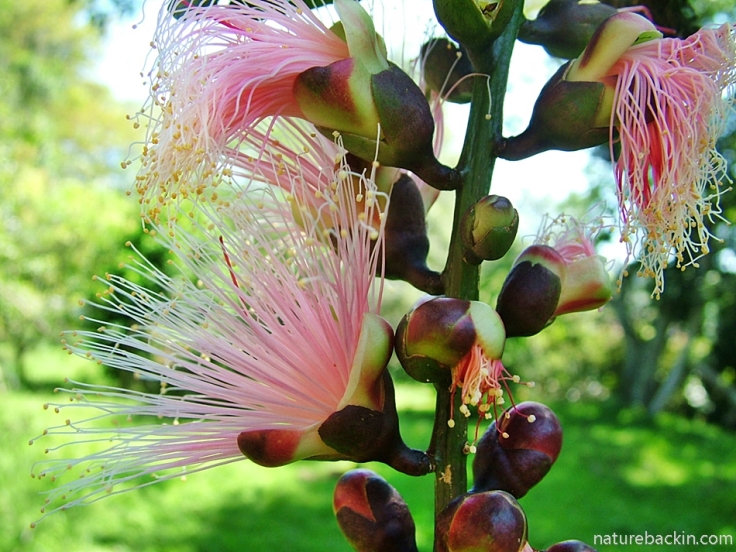
The showy flowers with elegant pink-tinged stamens grow on long racemes that can be up to a meter in length. This year, on our tree the racemes are longer and more numerous than they have been in previous years – I guess that might have something to do with the quantity and timing of the seasonal rains.

These buds, fairly evenly spaced along the long racemes, are just starting to open

The flowers on each raceme open and wither in succession. Some flowers wither on the tree, but others fall to the ground, creating a short-lived dainty carpet
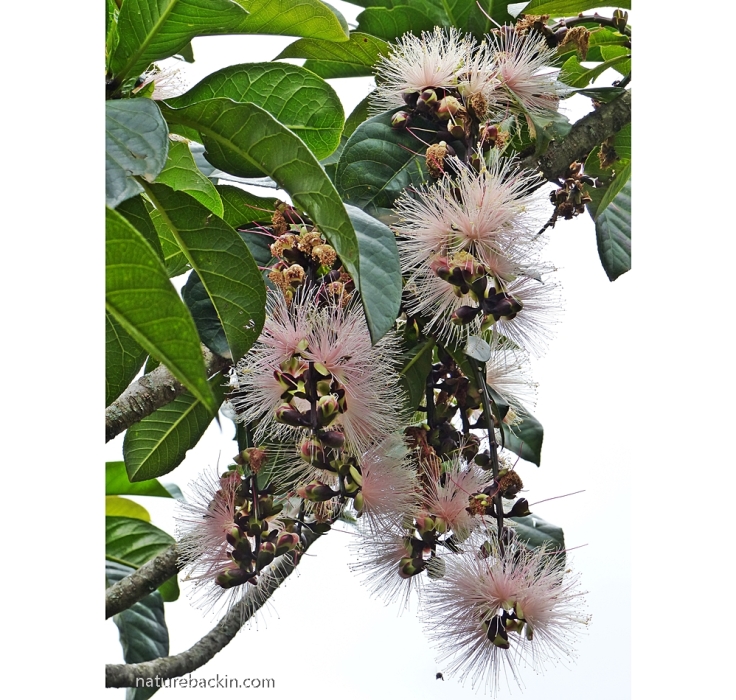
The long stamens form dainty sprays in powder-puff fashion. Flowers on trees that are in the sun are more deeply pink in colour than on trees in dense coastal forests, where the shaded flowers can be almost white
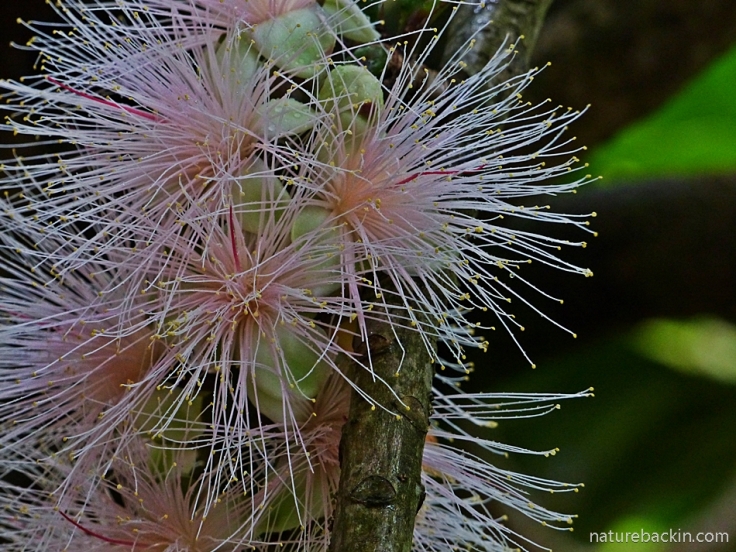
In the wild the Powder-puff Tree (Barringtonia racemosa) grows along the edges of coastal swamps, estuaries and rivers. In Southern Africa it occurs on the east coasts of Kwa-Zulu Natal and Mozambique, and also in Madagascar and it is widespread around the Indian Ocean, occurring in India, Sri Lanka, Malaysia, Thailand, Laos, southern China, northern Australia, Taiwan, the Ryukyu Islands off Japan and many Polynesian islands.
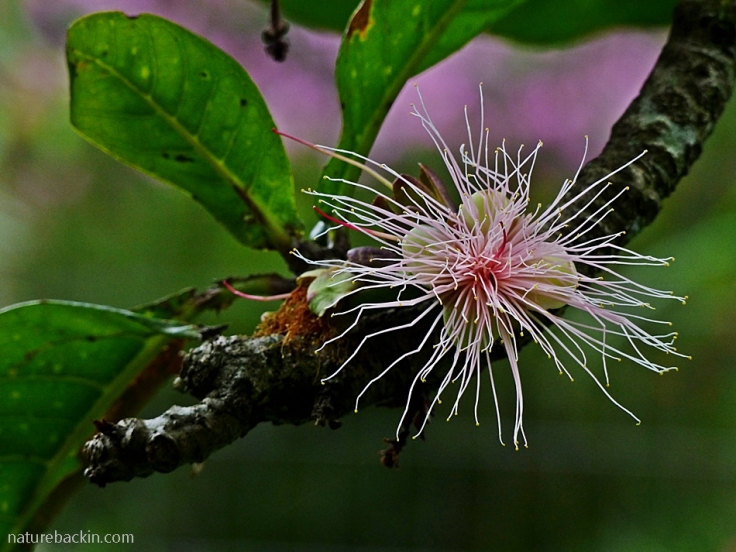
The flowers have a certain glamour, reminding me of richly embroidered silk panels
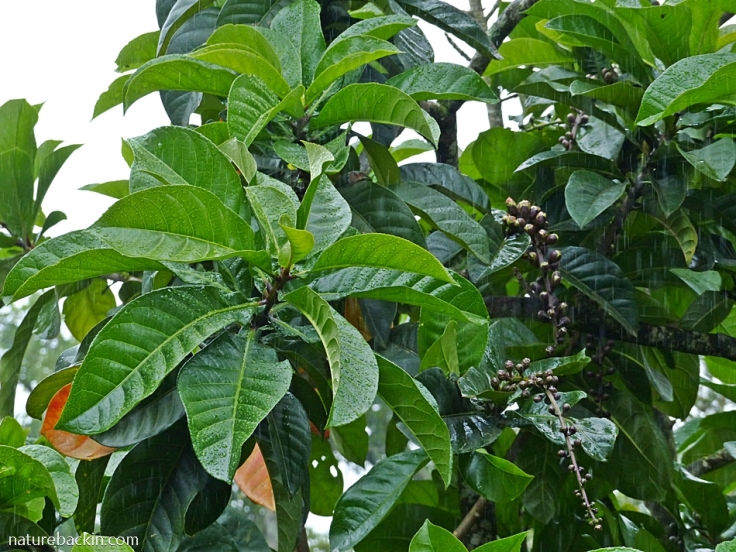
The above photo was taken a few days ago when it was raining lightly. The curved racemes laden with flower buds can be seen against the lush, deeply ribbed leaves that grow in a rosette formation. Throughout the year some leaves change colour through yellow to an orangey-red before falling and drying to a tough leathery brown.

On the branch of the Powder-puff Tree in the photo above, there is only one raceme that sports flowers that have dropped their petals and stamens, flowers that are in full bloom and buds that are yet to open. The leaves are also in three stages, new shoots, well developed green leaves, and some changing to orangey-red before dropping
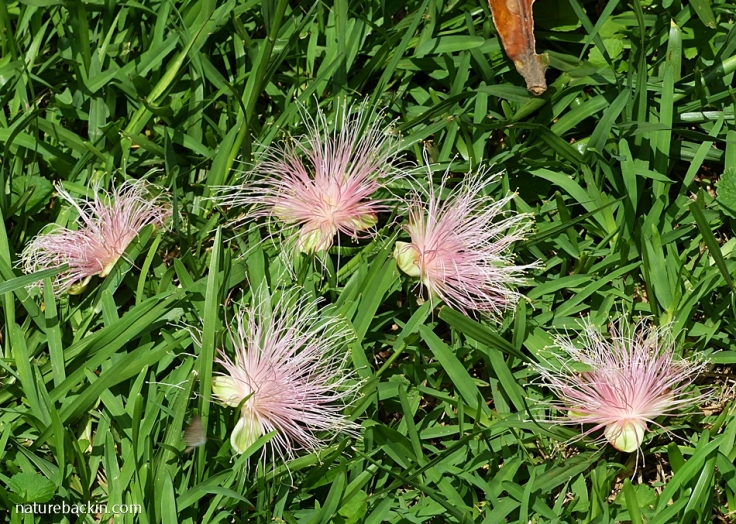
As the petals and stamens are shed some, especially in wet weather, remain stuck to the inflorescences or leaves, but many fall intact to the ground as can be seen in the photo above. In the Powder-puff Tree’s natural habitat where they grow in or near water, the fallen flowers can be seen floating and drifting on the surface of the water.
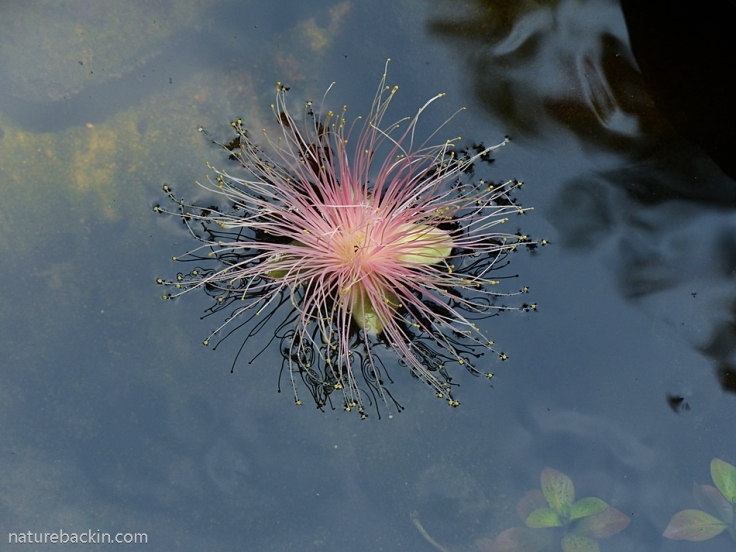
The photos above and below were stage-managed by me. I took one of the fallen flowers and floated it in the garden pond to show how prettily the flowers float on water, waving their tentacle-like stamens as they float, just as they so do in the tree’s natural swampy, estuarine or river habitats
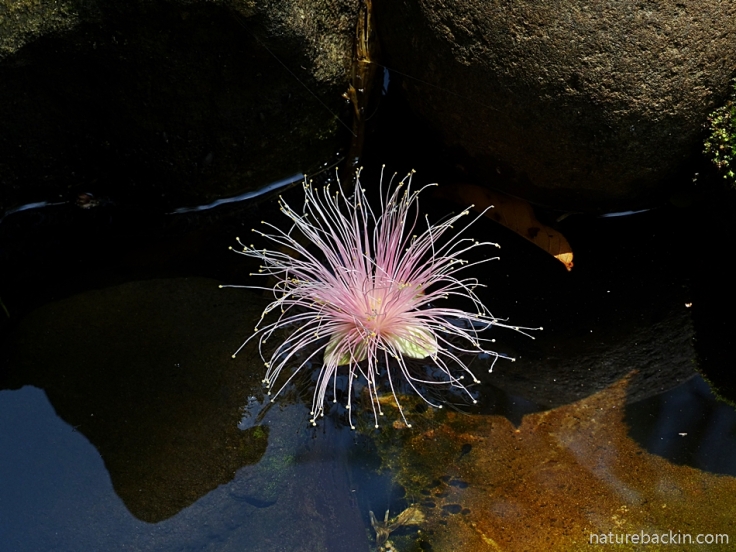
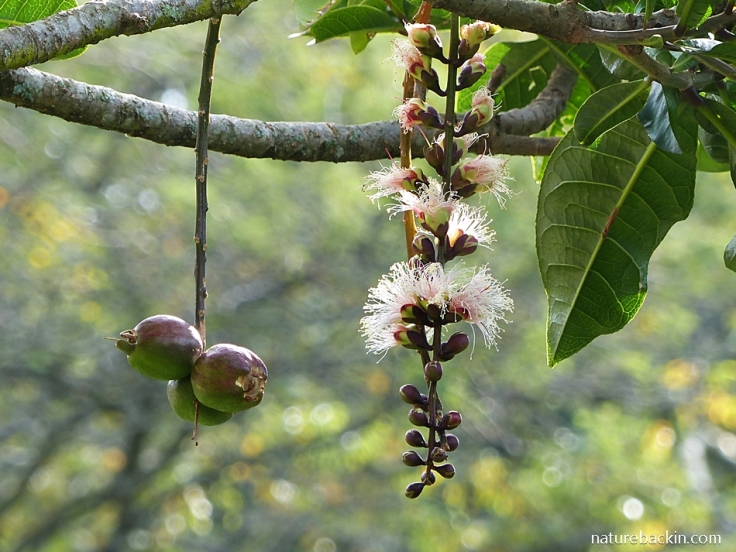
In time and after the flowers have fallen, fruits, each containing a single seed, develop on the racemes (see above).
In the photo below is a small collection of fallen seeds of different ages. The seeds’ outer covering shrivels becoming dry and fibrous enabling the seeds, after they have fallen to the water in their natural habitats, to float and be carried far and wide, dispersed by the tides.

The fruit, seeds, bark and roots of the Powder-puff Tree, containing a poisonous substance, can be pounded to be used as a fish poison. In India, one of the common names for Barringtonia racemosa is Fish-killer Tree. Extracts from the plant have also been used as an insecticide.
The tree contains chemical compounds that have pharmacological benefits, including having anti-fungal and anti-bacterial properties. In traditional medicines parts of the plant have several applications, such as being used to treat chicken pox or itchy skin, to treat coughs, sinusitis and bronchitis, to cure diarrhoea, and as a remedy to get rid of intestinal worms. In Southern Africa it has been used in traditional Zulu medicine to treat malaria.
Tannins can be made from the bark as well as dyes for vegetable fibres. The timber has many uses at the local level, but it is not used extensively commercially.
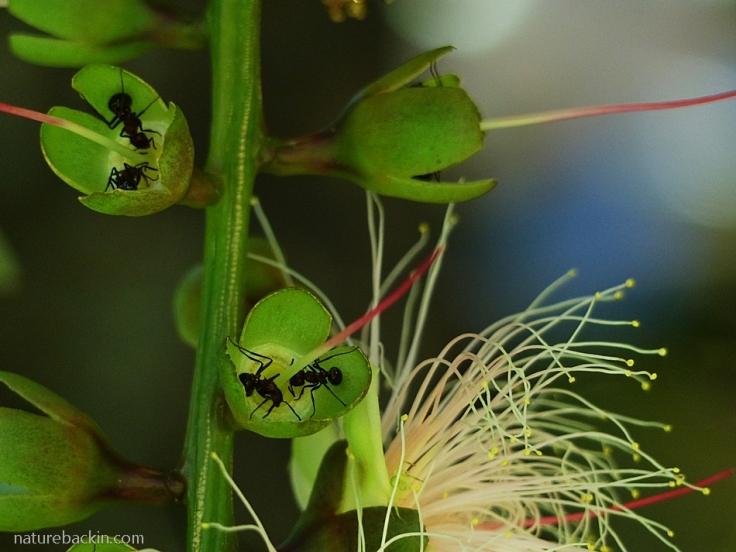
Ants are attracted to the nectar before the petals and stamens have dropped and also afterwards, as can be seen in the above photo. Honeybees are also attracted to the flowers
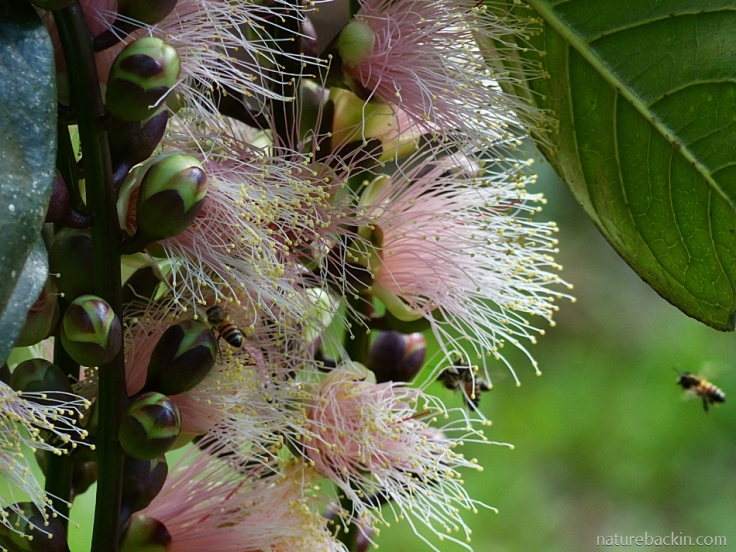
I have not tried it, but the plant can be propagated from cuttings and from seeds. Perhaps I should try, as this is a beautiful tree with a neat growth habit and so we might find space for a second tree in the garden. In some countries it is planted as a street tree.
Sources:
Boon, Richard. 2010 (2nd ed.). Pooley’s Trees of Eastern South Africa. Durban: Flora & Fauna; Cheek, Michael. 2008. Barringtonia racemosa. PlantZAfrica. SA National Biodiversity Institute (SANBI). http://pza.sanbi.org/barringtonia-racemosa; Tropical Plants Database, Ken Fern. tropical.theferns.info. 2019-01-23. http://tropical.theferns.info/viewtropical.php?id=Barringtonia+racemosa
Posted by Carol

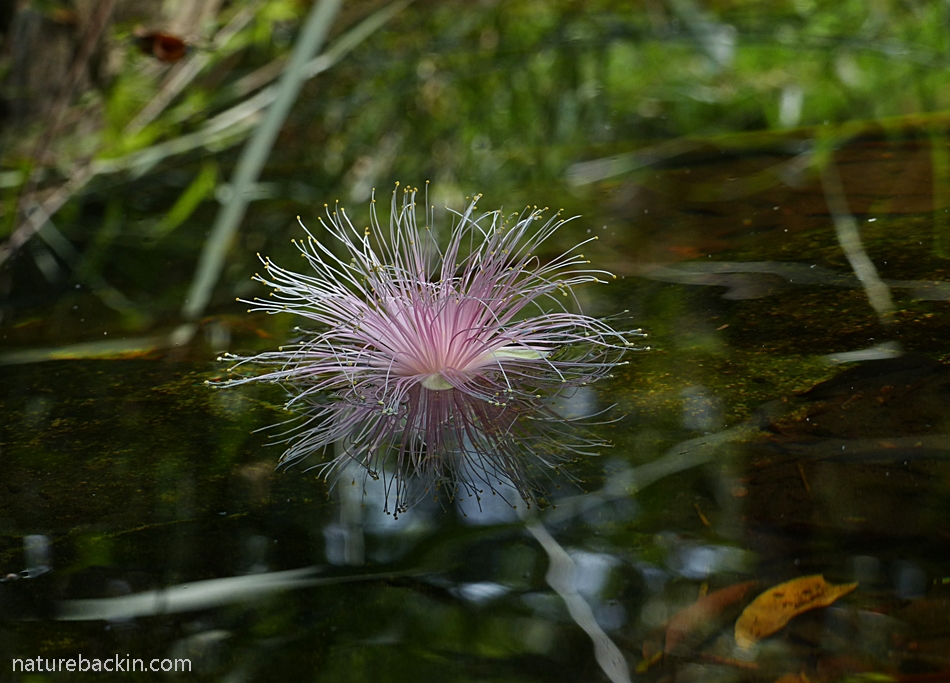







February 9, 2019 at 5:33 pm
It is indeed a beautiful tree, truly exotic and even a little alien looking (in the extra-terrestrial sense). It’s good to see that it’s useful to insects too; it’d be fascinating to see it visited by bats!
LikeLiked by 1 person
February 9, 2019 at 7:14 pm
You are right – I should make a special effort to sit up and see if any bats visit!
LikeLiked by 1 person
February 9, 2019 at 10:31 pm
Keep us posted! Or set up a camera…!
LikeLiked by 1 person
February 9, 2019 at 7:00 am
It’s an extraordinary tree! I could take pictures for hours! 😊 Have a nice holiday break! Simone
LikeLiked by 1 person
February 9, 2019 at 12:42 pm
Thanks Simone. It is a fascinating and photogenic tree! Thank you for the holiday wishes. We had a great time and now its nice to be home – and catching up!
LikeLiked by 1 person
January 27, 2019 at 12:05 pm
Fascinating. It is easy to get overwhelmed by the sheer number of plants in this world but all are unique and have stories worth studying. This tree is a particularly beautiful one, and its Indian Ocean distribution is interesting. I will look out for it next time that I am in south-east Asia.
LikeLike
January 27, 2019 at 8:20 pm
Yes I thought the distribution was interesting too, and is partly related to similar climates and seed dispersal by the tides I should think.
LikeLike
January 26, 2019 at 10:40 am
What a gorgeous and unusual (to me) tree! It would be a treat to see one in ‘real life’. Its flowers look so delicate and vulnerable and yet it has other uses as well. Surely a treasure for your garden.
LikeLiked by 1 person
January 26, 2019 at 8:12 pm
Yes it is a special tree and a treasure in the garden. It is near the house and so sheltered from any possible frost in winter. Apparently they do not cope at all well with frost. Apart from the one in our garden (planted by the previous owners of the house) I have only ever seen them in coastal forests on the eastern coast of Zululand.
LikeLiked by 1 person
January 25, 2019 at 4:39 am
What a fabulous tree. I much prefer the Powder puff name to fish killer, but it’s interesting how many beautiful plants are also very dangerous.
LikeLiked by 1 person
January 25, 2019 at 3:37 pm
It is a lovely tree. Although potentially dangerous to humans if ingested without proper preparation, it is widely used therapeutically and so it can be viewed as beneficial as well as beautiful I guess.
LikeLiked by 1 person
January 28, 2019 at 4:23 am
Like so many medicines, natural or otherwise – beneficial when used correctly, extremely dangerous when not.
LikeLiked by 1 person
January 25, 2019 at 2:14 am
What a feast for the eyes, Carol, and now you have me longing to flee the city’s chaos for Umlalazi again!
LikeLiked by 1 person
January 25, 2019 at 3:25 pm
Hopefully it won’t be too long before you can escape again. If its any consolation it is cool and very wet currently – not the best weather for Umlalazi!
LikeLiked by 1 person
January 24, 2019 at 8:46 pm
Such unusual and beautiful blooms. Nothing like it where I live. The essence
of “pretty poison”!
LikeLiked by 1 person
January 24, 2019 at 7:39 pm
What a fascinating read! I have really enjoyed learning about this tree – how wonderful to have one growing in your garden.
LikeLiked by 1 person
January 24, 2019 at 7:59 pm
Thanks Anne. Yes we are lucky – it was planted by the previous occupants of the house who were very committed to planting a diversity of indigenous plants in the garden.
LikeLike
January 24, 2019 at 4:05 pm
What a lovely tree. Though I’m quite surprised it may be used as a street tree if it has poisonous elements. The H&S police must have taken their eyes of the ball!
LikeLiked by 1 person
January 24, 2019 at 7:53 pm
I think you have to pound it and eat it for it to be a danger to humans. But even so it can be carefully prepared, which includes soaking, rinsing and cooking, so that the leaves and seeds may be eaten. It is not dangerous to touch or cut the leaves or wood, and the bark can be used in the treatment of itchy skin.
LikeLike
January 24, 2019 at 3:17 pm
A very beautiful tree – from buds to fallen flowers. Who would think it to be that poisonous? The floating flower is a wonder of beauty, and the scent sounds lovely as well. I would love to see one in real life. I will have to find out the nearest country!
LikeLiked by 1 person
January 24, 2019 at 7:40 pm
The scent can be a bit too pungent at times and some find it outright unpleasant. The flowers though are really lovely. You have quite a wide choice of countries to find them in 🙂
LikeLiked by 1 person
January 24, 2019 at 3:03 pm
A lovely tree with beautiful flowers. I do enjoy reading about the vegetation in your part of the world!
LikeLike
January 24, 2019 at 7:35 pm
It is a lovely tree. And likewise I enjoy your photos and observations in your part of the world.
LikeLiked by 1 person
January 24, 2019 at 8:14 pm
Thank you Carol.
LikeLiked by 1 person
January 24, 2019 at 2:33 pm
A beautiful tree… our local conservatory has red one that always delights us with it unusual blooms. I’ve also seen it on trips to the tropics, it seems to be widely cultivated. Not hard to see why!
LikeLiked by 1 person
January 24, 2019 at 7:32 pm
Yes it is beautiful and does well provided there is no frost I gather.
LikeLiked by 1 person